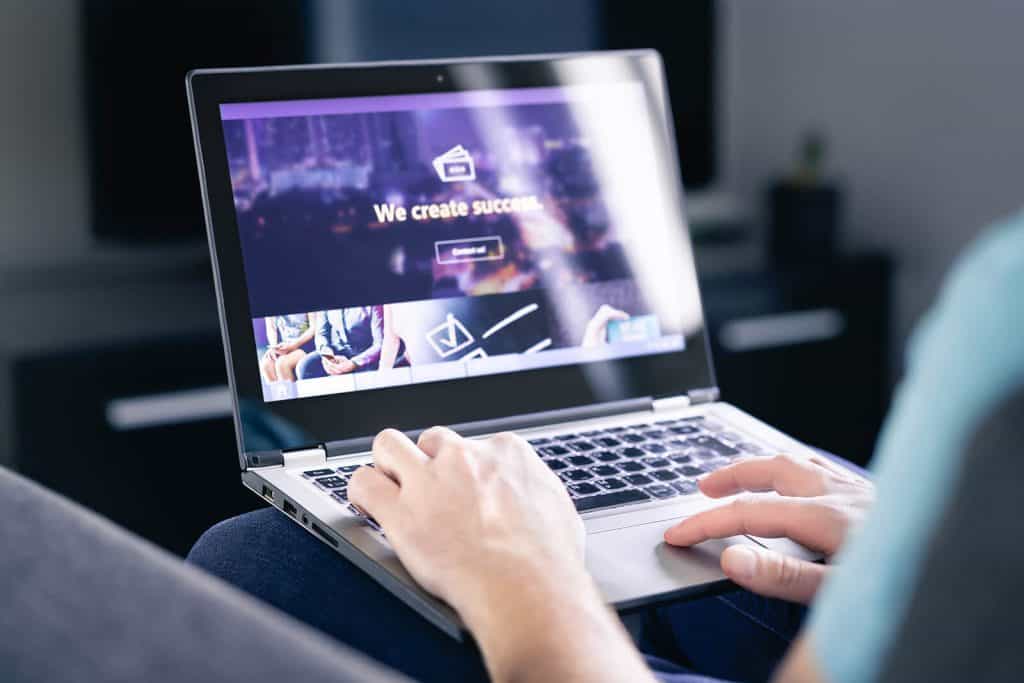(How to Make It Work for Your Company)
Regardless of the device you use, it has to have a user interface design (UI) because, without an interface, your device is not going to work. The UI could be as simple as the keyboard of your telephone because it’s the way your user interacts with the device. And nailing the UI right is imperative to ensure a fully functional and user-friendly interface.
Table of Contents
ToggleA good interface ensures users can use your product, app, or website seamlessly without getting any external help from anyone.
That’s why user interface designs are so important.
What is user interface design?
Let’s understand the UI design definition using a real-life example.
If you ever visited a website, what happens when you’re unable to comprehend the information offered by that website, or what would you do if you simply cannot navigate the pages?
You’re likely to turn away from a competitor offering similar services. Now, rewind a few seconds of your life and try to understand what was wrong with the first website you visited.
More than likely, the website lacked a solid UI design. So, if you’re a business that relies heavily on websites and apps to generate leads, you need to work on your UI design.
UI design is a process using which designers build interfaces for computerized devices, focusing only on the look or style. Most of the designers create interfaces that customers find easy to use and navigate. The UI includes design elements that a person requires to navigate with your site and make decisions. It is the link between your users and software applications.
It’s the UI that decides the overall design of your application, how your website interacts with users and how you present information to your users.
UI design includes:
- Input controls
- Informational components
- Containers
- Buttons and toggles
- Icons, tags, and lists
In short, user interface design is how you design your software or web application from your backend so that your users have a seamless front-end experience.
Businesses that give importance to UI interface are the ones that taste success and remain a customer favorite.
Types of UI designs
There are three types of user interface designs:
- Voice-controlled user interface (VUI) – users interact with all design elements through their voice. Most intelligent assistants like Alexa and Siri are a few examples of VUI design.
- Graphical user interface (GUI) – using visual representations on digital control panels, a user interacts with your application. A laptop’s startup screen of a computer’s desktop is a few examples of GUI.
- Gesture-based user interface – using bodily motions like augmented reality (AR) and virtual reality (VR), users engage with 3D design spaces.
Why does your application require an efficient UI design?
To create applications that meet your customer’s requirements, you require a design that helps solve their intended problem. That’s why for brands looking to make an impact, UI design is imperative.
- Acquires new customers
An intuitive and extraordinary UI design results in a positive customer experience that can provide your brand with a competitive advantage. The time and efforts you invest in creating a customer-tailored interface could become a key differentiator for your brand.
When customers know you offer something unique, they’re likely to prefer your brands over others. It will increase your sales and impact your bottom line. An excellent UI design interface successfully gives you revenue maximizing opportunities.
- Increases customer retention
Who doesn’t love coming back to a website or app that they can use smoothly? The better your navigation, the lower your chances of customers leaving your website without taking an intended action.
Imagine a website where you have to navigate three different pages to reach the ‘Contact Us’ page over a website where the ‘Contact Us’ page is visible at the upper right-hand corner? A customer wanting to connect with a brand is likely to prefer the second option. Why? The UI is well-designed and encourages customer engagement. This results in customer retention.
Today, with the changing landscape, retaining customers is touted as a cost-efficient way of growing a business because you’ve had the back of your loyal customers behind you.
- Helps build a brand
An efficient and user-friendly interface is likely to make your customers happy and satisfied.
Customers prefer brands that keep them happy and take care of their requirements. Happy customers are more likely to try an upgrade or invest in other aspects of your application. It builds your brand’s credibility and helps increase your brand value over time.
- Enhances productivity
With user-friendly navigation and UI design, your customers spend less time searching for information. WWhen a customer is happy, your brand successfully increases its sales volume, improves customer loyalty, and minimizes its cost and resources. So, a single UI design reflects increased productivity in both your brand and your user.
- Improves search engine ranking
While the bounce rate doesn’t affect your search engine rankings, your customers’ time on your website or application can improve your search engine ranking. However, this is closely related to bounce rate because when customers leave an application in a short duration, it indicates some issues with your website’s design or UI.
How to Make UI Work for Your Company
When building a website or application, it’s much more than simply putting all the pages together. It’s more about creating a seamless navigation experience for your users. To make your UI deliver results and create applications that your users never forget, follow these UI design principles.
- Keep the navigation menu simple
Creating an overly complex navigation menu and making navigation difficult for your customers is not going to work. To win your users, label every part of your landing page or application on the navigation menu and position them strategically. So, follow the industry norms and don’t make drastic changes to your navigation menu as it will push customers away.
Why use simple navigation? According to research, 37% of users said that a poor experience with site navigation forced them to leave that website.
- Focus on simple design
While fancy designs may be enticing and attractive to look at, they become problematic for users. When your website design is simple, your customers can search for information without facing any issues.
This removes confusion and provides a seamless shopping or browsing experience. A fancy design may ruin your dream of providing the best possible customer experience.
Why focus on simple design? It takes a customer less than 50 milliseconds to form an opinion about your website and these 50 milliseconds determine whether they will continue to your site or not. So, focus on creating a simple web design.
- Be steady and consistent
Across your website, ensure that your web design elements are using the commonly used design elements. It allows people to learn how website’s work and recognize patterns. Consistent patterns, languages, and functionality can help you achieve more than you can expect. Also, remember to create web pages that are commonly used on all websites.
Why remain steady and consistent? 44% of customers leave a website if they don’t find a ‘contact us’ page on your website. Also, 52% of customers expect to see an ‘about us’ section.
- Perform usability testing
It is a process where you watch a group of users interacting with your website to understand what elements are working and which elements users find hard to navigate and use. Based on usability testing, you can make changes to your design before your website or application goes for a launch. It can help you understand the user-interface elements, colors, and buttons when users clicked on them.
The primary purpose of usability testing is to ensure that the plan for an application’s or a website’s functions and features aligns with what the users want by observing a few people to use your application before the launch. From saving thousands of dollars to saving countless hours, usability testing helps you decode design issues early on.
Why perform usability testing? With most developers and designers spending 50% of their time trying to fix avoidable issues, usability testing could help you improve your design during the first phase of your project.
- Give importance to typography
Like the color, size, and shape of buttons or toggle impacts usability, so does typography. The typography makes your text visible and helps them understand what’s written on your web pages. So, test out different typographies and use ones that yield the best results. Again, never focus on fancy typography as it degrades your website or application readability.
Why focus on typography? The number one complaints of web visitors are contrast and small font sizes.
Conclusion
For business success and growth, user interface design is essential. UI design is the way your website speaks and interacts with your users. Also, it’s the way your audience sees and understands your business.
It’s an element of your design phase that you shouldn’t overlook. Instead, give it time to create a website or applications that resonate with your target audience while providing seamless navigation.
How are you using user interface design to benefit your company?
Please share your thoughts with us!




